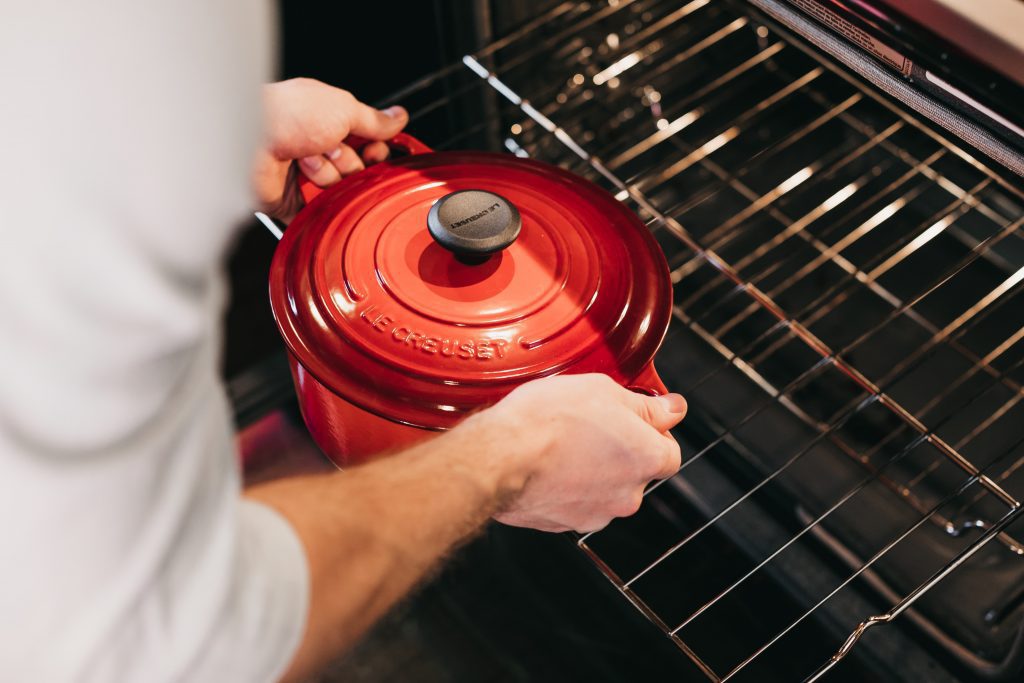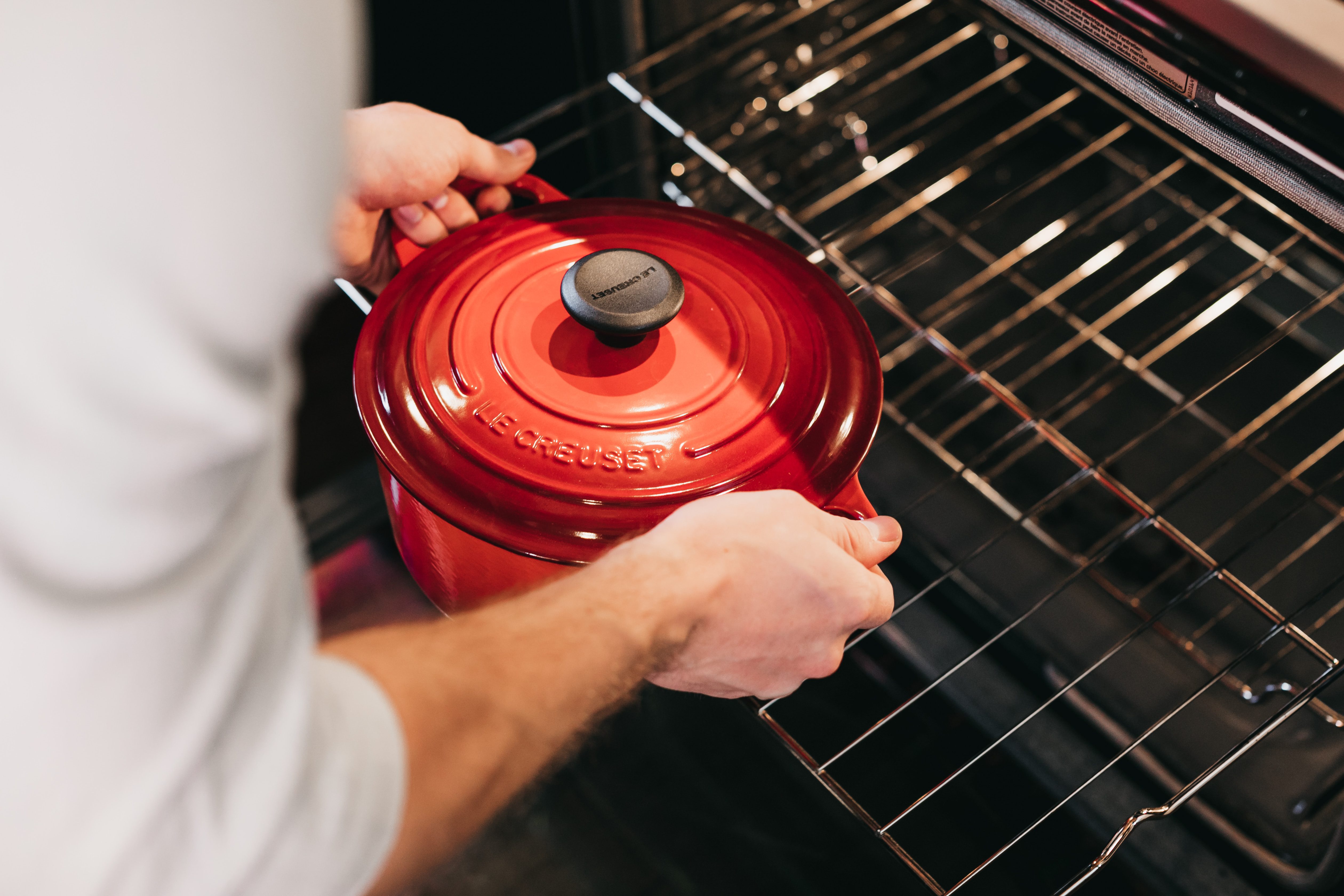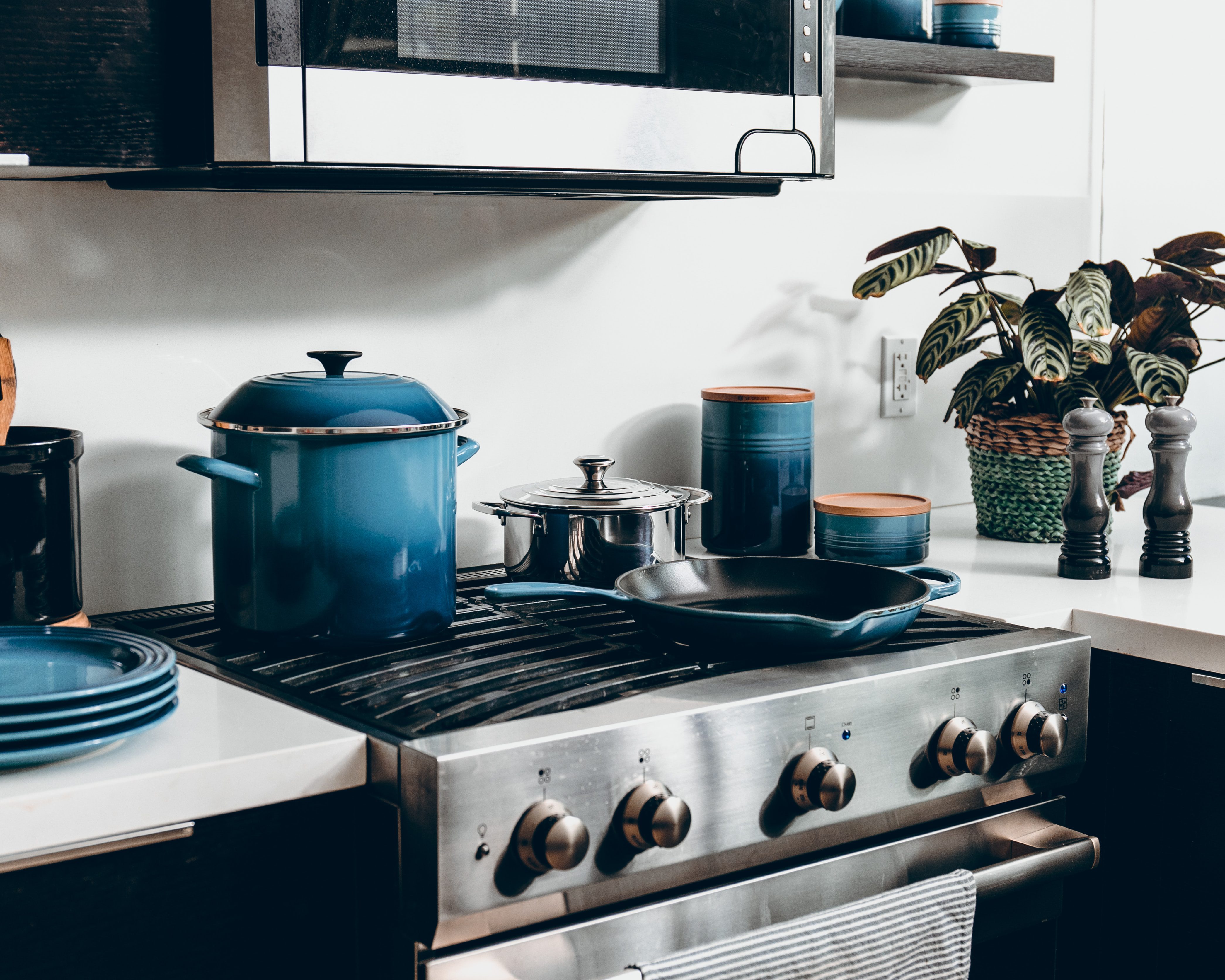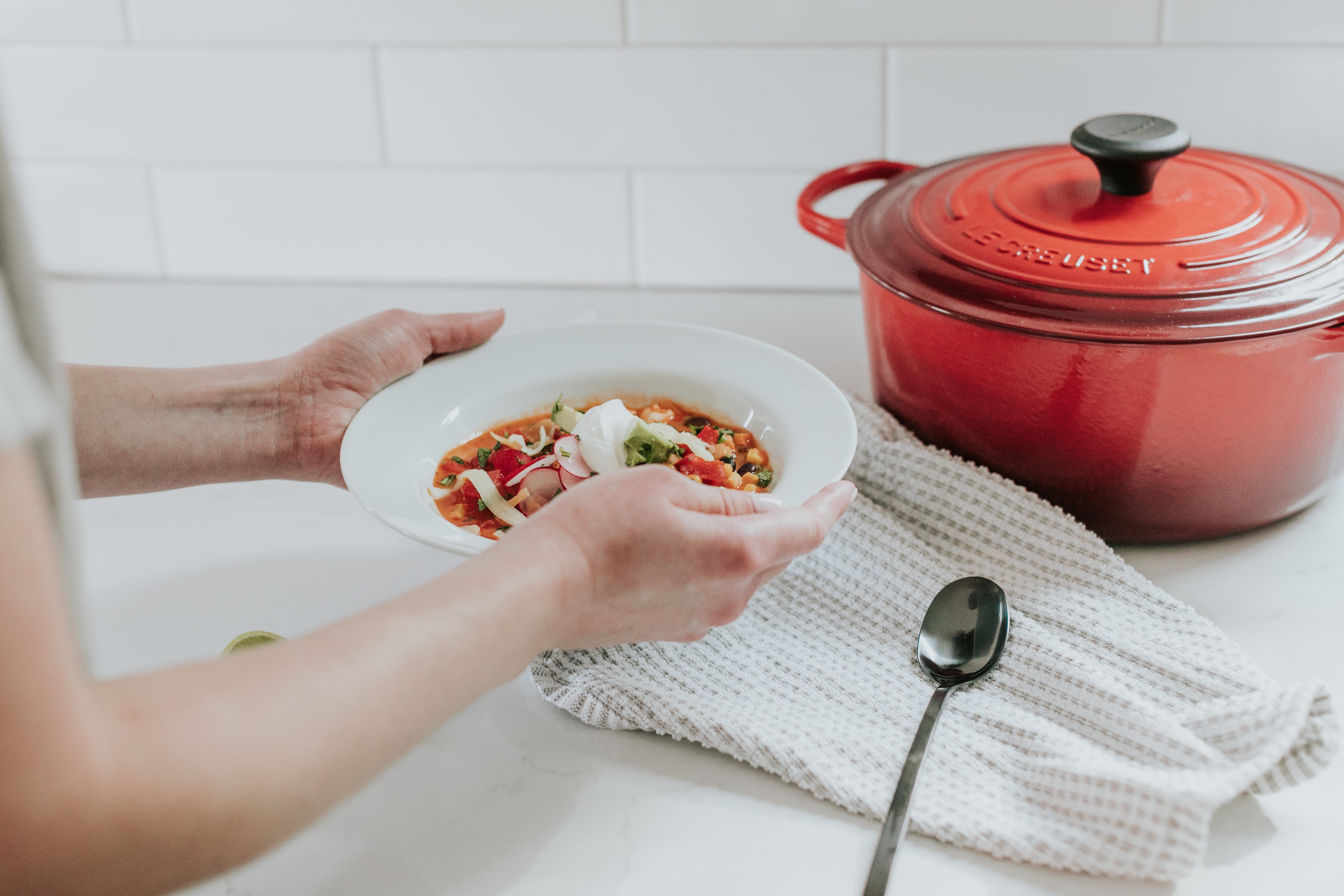Image via unsplash
The Dutch oven is one of the oldest cooking vessels still in common use today. Durable to the point that many Dutch ovens are passed down through the generations, and versatile enough to be used in a variety of different cooking methods, it is understandable that the Dutch oven has lasted so long. But what is a Dutch oven? This article will answer that question as well as look at the origins of the Dutch oven and even provided some interesting ways to put it to use.
What Is A Dutch Oven?
To put it simply, a Dutch oven is a cooking pot with a tight-fitting lid and thick walls. Most Dutch ovens are made from seasoned cast iron, though Dutch ovens made from enameled cast-iron or even cast aluminum or ceramic are also available.
Cast-iron became the metal of choice for Dutch ovens due to its inexpensive nature and its ability to retain heat evenly and for a long time. Cast-iron alone does not offer any protection against food sticking or rust, so it must be seasoned and cared for in a specific way. This is caused enameled cast-iron to grow in popularity as it is much easier to clean.
History Of The Dutch Oven
When answering the question, what is a Dutch oven, taking a brief look at its history can be illuminating. The history of the Dutch oven begins in Europe during the 17th century. From these early origins, it changes as the English begin making them out of cast iron. It morphed again as the English settlers brought their cast iron Dutch ovens to America, where it became a cherished cooking pot that the settlers of the west took with them on their wagon trains
Dutch Origins
Cast metal cookware first became popular in the 17th century, with brass being the metal of choice. The Dutch had perfected a casting method that used sand in the casts, and this allowed them to all but monopolize cast brass cookware with their cheaper production costs.
At this time the English made their casts from the more difficult to work with clay or loam. This Dutch monopoly would end when British businessmen Abraham Darby visited the Netherlands and learned the Dutch secret of using sand in their casts.
English Dutch Ovens
Abraham Darby didn’t just switch his Bristol Brass Work plant’s casts from clay and loam to sand; he also switched from brass to the much less expensive cast iron. His initial attempts at substituting cast-iron for brass were failures, but his company soon pushed past those poor initial attempts and patented a method of processing cast-iron in 1707. It is here where the Dutch oven got its name, because Abraham Darby’s cast iron pans were made in the Dutch process. These newer Dutch ovens, with their lower cost, became quite popular in England.
The Dutch Oven Comes To America
In the colonial period, English settlers to the American colonies brought with them Dutch ovens. These new Americans made several changes to the Dutch oven to make it more suitable for frontier cooking. The two most important changes to the design are credited to Paul Revere. In addition to his place in American history for his famous ride, Paul Revere was a silversmith. In this capacity, he also made Dutch ovens and added feet to the Dutch ovens as well as adding a lip to the lid to better allow hot coals to be placed on top of the Dutch oven.
In the 19th century, as Americans explored the Western half of the continent, they brought Dutch ovens with them. Lewis and Clark brought Dutch ovens on their famous expedition. Both wagon trains and Mormon handcart companies brought Dutch ovens with them as they traveled west. The iconic American cowboys ate food cooked in Dutch ovens from their chuck wagons during their cattle drives.
Dutch ovens remained popular, along with cast iron skillets, well into the 20th century in America. In fact, Lodge Manufacturing, one of America’s oldest cookware companies specialized in the production of cast-iron skillet’s and Dutch ovens. While the demand for this cookware has fallen, it is still well loved by most who use them as cast-iron cookware can last a lifetime and provides unrivaled heat retention.
Different Types Of Modern Dutch Ovens
We have answered the question “what is a Dutch oven” and looked into the brief history of this famous cooking pot, but if you’re looking to purchase a Dutch oven, you will need to know the different styles available so you can pick the one that best fits your intended use. There are generally three types of Dutch ovens on the market today: traditional cast-iron, enameled Dutch ovens, and campfire Dutch ovens.
Cast Iron VS Enameled
For most people who are considering purchasing a Dutch oven, they will not need a campfire model; which leaves them looking between cast-iron or enameled Dutch ovens. Enameled ovens require less specialized care than cast-iron to keep them in working shape, but the enamel on a cast iron pan will slow the healing of the already slow healing cast-iron. As most Dutch oven dishes are cooked for a long period of time, this might not be a problem for most people.
The other benefit of enameled cast-iron Dutch ovens is with acidic food. Cast iron is reactive cookware, and with more acidic foods such as tomato sauces or wines, some of the cast iron can leach into the food, giving it a metallic taste. Enameled Dutch ovens do not have this issue.
Cast iron Dutch ovens have their benefits as well. Cast iron can be seasoned to provide a virtually nonstick surface, and should that seasoning be removed, the seasoning on the pan can be reapplied. Even if the Dutch oven rusts, the rust can be scrubbed and the seasoning applied again. This gives cast-iron Dutch ovens a durability that enameled Dutch ovens just do not have.
Campfire Dutch Oven
In the brief history section of our article answering the question of “what is a Dutch oven,” we detailed Paul Revere’s changes to the Dutch oven. His addition of feet and a lip to the lid of the Dutch oven created what is now known as the “campfire Dutch oven.” These additions make using the campfire Dutch oven over a wood fire much easier. If you intend to use your Dutch oven over a wood fire, consider getting a campfire model. Due to the feet, this model is not a good choice for stovetop use.
Caring For A Cast Iron Dutch Oven
Image via unsplash
Cast-iron does require a little extra care compared to your other pans. First, the cast iron Dutch oven needs to be seasoned. This entails heating it and applying layers of oil to its surfaces. Seasoning will provide a nonstick surface and also protect the cast-iron from rusting.
This seasoning also requires cast iron Dutch ovens to be cleaned without the use of soap. Rinsing with hot water before drawing completely and applying more oil is the preferred method for cleaning a cast iron Dutch oven. Scouring it when dry with rock salt can also be used if the food does stick.
Dutch Oven Uses
Image via unsplash
The Dutch oven is one of the most versatile cooking pot you can buy. Normal Dutch ovens can be used on the stove, in the oven, on a campfire, and even on a grill. This section looks at specific types of dishes and cooking methods that a Dutch oven can provide. In essence, you can use a Dutch oven as you would any other cooking pot: but you can also do more with it.
Soups And Stews
Due to its ability to retain heat, the Dutch oven is a perfect vessel for making soups and stews. There are no limits to the types of soups and stews that can be made in a Dutch oven; but remember that seasoned cast iron might leach into more acidic liquids. If you use a seasoned cast iron Dutch oven, it might be best to not make tomato or wine based soups or stews.
Roasts
The Dutch oven is an unparalleled pan for roasts of all types. With its ability to retain heat, the low and slow method of roasting meats is a great use of the Dutch oven. You can make it a one-pot meal by adding vegetables, and once it is done cooking you can make a delicious pan sauce from the drippings.
Casseroles
Casseroles are another option for the Dutch oven. As this cookware can also be used on the stove, this is an ideal way to make a one-pot casserole dish.
Bread
In the last several years, a no-knead bread cooked in the Dutch oven has become a popular dish. The Dutch oven will provide an excellent crust, browning beautiful round loaves of bread. Many bread recipes can be adapted for use in a Dutch oven
Desserts
The Dutch oven is a good choice for many desserts. A classic campfire use of the Dutch oven from the Boy Scouts is a campfire peach cobbler. Many Dutch oven desserts require few ingredients and little work, making them great for camping.
Conclusion
We hope that our article answering the question, “what is a dutch oven” has done more than just provide the answer. Hopefully it has inspired you with an interest in Dutch oven cooking.






